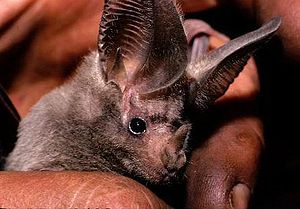Leaf noses
| Leaf noses | ||||||||||||
|---|---|---|---|---|---|---|---|---|---|---|---|---|

California big-eared nose ( Macrotus californicus ) |
||||||||||||
| Systematics | ||||||||||||
|
||||||||||||
| Scientific name | ||||||||||||
| Phyllostomidae | ||||||||||||
| Gray , 1825 |
The leaf noses (Phyllostomidae) are a family of bats (Microchiroptera) restricted to America . It is a diverse, species-rich group that includes around 50 genera and 150 species. The best known representatives are probably the vampire bats (Desmodontinae).
distribution
Leaf noses are native to the tropical and subtropical regions of America. Their distribution area extends from the southern USA to northern Argentina and also includes the West Indies .
description
The name-giving feature is a nasal blade that is present in most species , which is used to guide ultrasound sounds for echolocation . This has a simple lance-shaped structure and is more simply built than the old-world horseshoe bats (Rhinolophidae) or large-leaf noses (Megadermatidae). Other species have bump-shaped or wart-shaped structures on the chin. In species that feed on fruits or nectar, the nasal sheet is receding, these animals have instead developed protruding snouts and long tongues. The animals have between 26 and 32 teeth, which are shaped differently depending on their diet.
The size of the leaf noses varies considerably. In addition to a number of very small species, this group also includes the large spit leaf nose ( Vampyrum spectrum ), one of the largest bats at all with a weight of 200 grams and a wingspan of 90 centimeters. The fur of most species is reddish, gray or brown in color, but there is also a white species, the white bat ( Ectophylla alba ); in addition, several species have white stripes on their backs or faces.
Way of life
Leaf noses inhabit a wide variety of habitats, from rainforests to desert areas . Most species are nocturnal; caves, crevices, animal burrows, hollow tree trunks, but also man-made dwellings such as mines, tunnels or buildings serve as sleeping places. Some species also build tent-shaped shelters from large leaves. Many species sleep in large groups, some even alone. Some species in cooler areas hibernate, while others migrate to warmer areas during the winter months.
food
Leaf noses have a wide variety of eating habits. Many species are insect eaters , and some larger species also eat small vertebrates. Others ingest nectar or pollen and play an important role in the fertilization of the plants, and still others consume fruit. There are also omnivorous species. The vampire bats have developed a diet that is unique among mammals and consumes only blood.
Reproduction
Most species give birth to a single cub once a year. Delayed implantation, as has been observed in other bats, should not occur in the leaf noses.
Systematics
Despite many studies, the system of leaf noses has not yet been fully clarified. Eight subfamilies can be distinguished:
- Vampire bats (Desmodontinae)
- Lance noses (Phyllostominae)
- Fruit vampires (Stenodermatinae)
- Short-tailed leaf noses (Carolliinae)
- Antilles fruit vampires (Brachyphyllinae)
- Antilles blossom bats (Phyllonycterinae)
- Lonchophyllinae
- Flower bats (Glossophaginae)
Other classifications are based on only four subfamilies, in this concept the short-tailed leaf noses (as Carolliini) are assigned to the fruit vampires and the Antilles fruit vampires (as Brachyphyllini), the Antilles blossom bats (as Phyllonycterini) and the Lonchophyllinae (as Lonchophyllini) are assigned to the blossom bats.
Phylogenetically , the vampire bats stand opposite the other leaf noses, the relationships can be shown in the following diagram:
| Leaf noses (Phyllostomidae) |
|
||||||||||||||||||||||||||||||||||||||||||
|
|
literature
- Ronald M. Nowak: Walker's Mammals of the World . Johns Hopkins University Press, 1999, ISBN 0-8018-5789-9 .
Web links
- Phylogenetic pedigree of the bats including leaf noses by Kate E. Jones u. a. ( Memento of July 18, 2004 in the Internet Archive ) (English, PDF)
- Phyllostomidae or the New World Leaf Noses - Accessed January 31, 2008